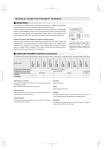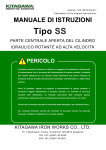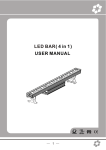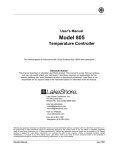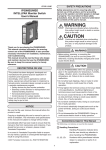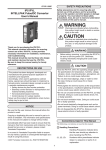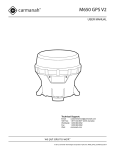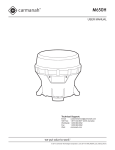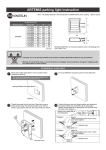Download C-107
Transcript
TECHNICAL GUIDE FOR PROXIMITY SWITCHES DEFINITIONS "Proximity switch" includes all switches that detect the presence of a metallic object approaching the sensing face or near the sensing face without mechanical contact. The target object and switch form what appears to be a transformer-like relationship. There are detection systems that use the eddy currents that are generated in metallic target objects by electromagnetic induction (most Azbil proximity switches), systems that detect changes in electrical capacity when approaching the target object, etc. The Japanese Indus- Target object trial Standards (JIS) define them as inductive and capacitive proximity switches respectively. switch Detection principle of high-frequency oscillation proximity switches High-frequency oscillation proximity switches detect magnetic loss due to eddy currents that The transformer-like coupling condition is replaced by impedance changes due to eddy-current losses. The impedance changes can be viewed as changes in the resistance that is inserted in series with the target object. are generated on a conductive surface by an external magnetic field. An AC magnetic field is generated on the detection coil, and changes in the impedance due to eddy currents generated on a metallic object are detected. Other systems include aluminum-detecting switches, which detect the phase component of the frequency, etc. Azbil PROXIMITY SWITCH CATEGORIES Categorization by actuation method Categorization by structure Categorization by sensing head shape Shielded Unshielded High-frequency oscillation Built-in amplifier Cylindrical Square High-frequency oscillation Cylindrical The switch is turned ON and OFF when a metal object approaches the sensing face (coil). Most Azbil proximity switches are this type. Round sensing face DC2-wire APT DC2/3-wire FL2R-V DC3-wire FL2 DC2-wire FL2R/S DC2-wire FL2F DC2/3-wire APM AC/DC2-wire FL7M DC2-wire FL7M-A DC3-wire FL7M Series name DC2-wire FL7M The following table summarizes Azbil proximity switches by actuation method, structure (built-in or separate amplifier), sensing head shape and shielding: Amplifier-Relayed Cyl./Sq Square Square-shaped sensing face Built-in amplifier Resists influence from electrical noise because the sensing coil is integrated with the oscillation circuit. Shielded The sides of the sensing coil are covered with metal. This structure is robust and less likely to be affected by surrounding metal. Amplifier-Relayed The sensing coil and the oscillation circuit are separate. This allows the sensing face to be smaller. 1 Unshielded The sides of the sensing coil are not covered with metal. This allows the sensing distance to be made longer. GLOSSARY Standard target object Perpendicular operation Reset (OFF) Standard target object SPCC Actuated (ON) DT Differential travel D Rated sensing distance Return distance Reference point A target object that is used for measuring the sensing distance. Normally, this is a square iron plate (cold-rolled steel sheet, SPCC) of standard size. Generally, the size of the standard target object is the minimum target object size so that a fixed sensing distance can be achieved. Accordingly, the proximity switch is actuated at approximately the rated sensing distance if the target object is larger than the standard target object and of the same material and thickness. Proximity switch Standard target object Generally, the sensing distance of a proximity switch is measured by this perpendicular actuation method. Proximity switch d Parallel operation Reset (OFF) (Sensing distance) Ex.: FL7M DC 2-wire shielded switch, O.D. M8: Iron 8 x 8 mm, t=1 mm d t (Differential travel) Actuated (ON) Standard target object SPCC Reference axis Reference point Differential travel This is the difference between the distance (sensing distance) at which a standard target object approaching perpendicular to the sensing face actuates the proximity switch and the distance (reset distance) which the standard target object must move away for the switch to return to OFF. This is expressed as a percentage of the sensing distance. Proximity switch OFF Usable sensing distance This is the distance to the target object from the sensing face at which the target object can be stably detected when it approaches from a direction that is parallel to the sensing face. Normally, this is 70 to 80 % of the rated sensing distance. Rated sensing distance Usable sensing distance Note: Iron target of standard target object dimensions or more Sensing distance Reset distance Rated sensing distance This is the distance to the target object from the sensing face at which the proximity switch is actuated when a standard target object approaches in a direction that is perpendicular to the sensing face. ON Target object Expressed as the measured distance from the reference point when the standard target objects moved parallel to the sensing face. This distance depends on the moving path (distance from the reference point), so it can be expressed as an operating point locus (sensing area diagram). Difference travel Ex.: FL7M DC 2-wire shielded switch, O.D. M8: 15 % max. of sensing distance Mutual interference This refers to the state in which performance and characteristics (e.g. sensing distance) are influenced when two or more switches are positioned close to each other. Off-state current In the case of 2-wire proximity switches, a slight current flows to activate internal circuits even when output is OFF. This is referred to as off-state current. Since off-state current is present, a voltage equivalent to load resistance x off-state current is exerted on the load even when the proximity switch is OFF. Note that this will cause reset failure of the load if the off-state current exceeds the load reset voltage. Ex.: FL7M DC 2-wire shielded switch, O.D. M8: 0.55 mA max. Switching current Sensing face Target object This refers to the minimum current required by the proximity switch and the maximum current that the proximity switch can switch. switching current •TheMaximum maximum current that is allowed to flow to the output circuit when the proximity switch is ON. If the current is greater, the load short-circuit protection circuit will be activated, or the proximity switch will be damaged. 2 Minimum switching current The minimum required current that flows to the internal circuits when the proximity switch is ON. At a lower current, the switch will not operate. If the load resistance is too large and results in the load current not satisfying this minimum switching current, connect a bleeder resistor in parallel to the load to lower the total load resistance. Shielded With a shielded switch, magnetic flux is concentrated in front of the switch and the sides of the switch coil are covered with metal. The switch can be mounted by embedding it into metal. Ex.: FL7M DC 2-wire shielded switch, O.D. M8: 3 to 100 mA Voltage drop This is the voltage that is generated across the output and 0 V terminals (DC 3-wire proximity switch) or the switch output terminals (DC 2-wire proximity switch). Note that the load sometimes cannot be actuated when output is ON as this voltage drop occurs. Proximity switch Ex.: FL7M DC 2-wire shielded switch, O.D. M8: 3.0 V max. Target object Operating frequency This is the maximum number of sensing per second in which output can be made proportional to repeated approaches of the target object to the sensing face. Operating frequency expresses response speed. f= 1 t 1+ t 2 Proximity switch t1 1/2 (Sensing distance) 2M M t2 Unshielded With an unshielded switch, magnetic flux is spread widely in front of the switch and the sides of the switch coil are not covered with metal. This model is easily affected by surrounding metal objects (magnetic objects), so care must be taken in selecting the mounting location. t3 Standard target object M Proximity switch Non-metal Temperature drift This indicates how much (in %) the sensing distance changes when the operating temperature differs from the standard 25 ˚C. Ex.: FL7M DC 2-wire shielded switch, O.D. M8: ±10% max. of sensing distance for the -25 to +70˚C range Power voltage drift This indicates how much (in %) the sensing distance changes when the power voltage differs from the rated power voltage. Ex.: FL7M DC 2-wire shielded switch, O.D. M8: ±10% max. of sensing distance with a ±15% voltage fluctuation. 3 Target object GENERAL CHARACTERISTICS 1. Sensing area diagram Below is a plot of the sensing range when the size of one side of the target object is fixed and target thickness changes. This is a plot of points at which the proximity switch is actuated (measured from the edge of the standard target object) when a standard target object approaches parallel to the sensing face. Target object: Al Sensing distance (mm) (typical) Thickness of target object and sensing distance (typical) FL7M-156 Standard target object Iron 30 x 30 x 1 mm 16 14 Standard target object FL7M-86 Standard target object Iron 18 x 18 x 1 mm Sensing distance Y (mm) 12 10 Thickness (mm) 8 FL7M-46 Standard target object Iron 12 x 12 x 1 mm 6 4 2 0 15 10 5 0 5 10 15 Sensing distance X (mm) 2. Sensing distance according to material and size of object The sensing distance varies according to the material and size of the target object. If the target object is 1 mm or more thick, a standard sensing distance can be obtained which will hardly change regardless of the thickness of the target object. If the target object is less than 1 mm thick, the sensing distance will change according to the thickness of the target object. Note particularly that if the target object is nonmagnetic metal (e.g. copper, aluminum), the sensing distance increases with decreased thickness and at about 0.01 mm thick is almost the same as for magnetic metal (e.g. iron). 3. Voltage drop characteristics diagram This indicates the output voltage (V) of the proximity switch in proportion to load current (A) when the proximity switch is ON. (This is called “output voltage drop.”) It also indicates the output voltage (V) when the proximity switch is turned OFF in proportion to load current (A) when the proximity switch is ON. The value obtained by subtracting this output voltage value from the power voltage is called “load voltage drop.” Sensing distance according to material & size of object (typical) Voltage drop (V) Voltage drop characteristics (typical) Sensing distance X (mm) Iron SUS Brass Load current (mA) Aluminum Copper Size of one side of target object d (mm) 4. Off-state current characteristics diagram This indicates how off-state current (which flows when the proximity switch is OFF) changes in proportion to changes in the power voltage. Off-state current characteristics (typical) FL7-26H Off-state current (mA) Generally, the sensing distance on non-iron targets is shorter than that for iron targets. The sensing distance is almost the same if the target object is made of iron and is larger than a standard target object. If the target object is not made of iron, or its dimensions are smaller than the standard target object, measure the actual sensing distance with the target object while referring to the graph above, and mount the proximity switch so that the usable sensing distance is 70 % or less of this value. FL7M-36H FL7M-76H FL7M-106H Power voltage (V) 4 SELECTION OF PROXIMITY SWITCHES The following introduces typical points to take into consideration when selecting a proximity switch. 1. Operating conditions 3. Switch body type Sensing distance The usable sensing distance is about 70 % of the rated sensing distance. However, to ensure reliable sensing, it is advisable to take factors such as drift in proximity switch performance, meandering of target objects, and conveyor undulation, and allow a certain degree of margin when using the switch. On the other hand, for high resolution, using a model with a short sensing distance will provide better results. Select a body type that is suited to the location where the proximity switch is to be used. 4. Electrical conditions Verify the electrical conditions of the control system to be used and the electrical performance of the proximity switch. Proximity switch 2.1 Surrounding metal When there is a metal object other than the target object near the sensing face of the proximity switch, the sensing performance of the proximity switch will be affected, and the apparent sensing distance will increase and become unstable. When the proximity switch is flush-mounted in metal, use a shielded switch with a sensing coil whose sides are covered with metal. If you use an unshielded switch, be sure to mount it away from surrounding metal by at least the recommended distance. Resistive load: Non-contact control system Inductive load: Relay, solenoid, etc. • Steady-state current, inrush current • Operating, reset voltage (current) Lamp load • Steady-state current, inrush current Open/close frequency Selecting the power supply type DC AC Selecting the power supply type DC AC Output Switching current Off-state current Voltage drop 6. Target object moving speed Surrounding metal To select a switch for a target object moving at high speed, use the following calculation based on the operating frequency (operating time) of the proximity switch, length of the target object, and distance to the target object. Proximity switch 2.2 Environment The environmental resistance of the proximity switch is better than that of other types of switches. However, investigate carefully before using a proximity switch under harsh temperatures or in special atmospheres. Vibration and shock Load DC (voltage fluctuation, maximum current) AC (voltage fluctuation, frequency, etc.) DC proximity switches have a higher operating frequency than AC ones. Use DC models if high-speed response is required. Sensing distance Atmosphere Power Load 5. Operating frequency Target object Temperature and humidity Output Switching element Power 2. Environmental conditions Highest or lowest values, existence of direct sunlight, etc. Temperature influence, high-temperature use, low-temperature use, need for shade, etc. Water, oil, iron powder, or other special chemicals Need for water resistance or oil resistance, need for explosion-proof structure. Intensity, duration Need for durability, mounting method 1 < Ds + Dt Rt St + Db – Dt (sec) St Rt: Operating frequency (Hz) Ds: Width of sensing area (mm) Dt: Length of target object (mm) Db: Distance between target objects (mm) St: Speed of target object (mm/s) Select a switch that fits the characteristics of the target object. St Target object Explosive atmosphere Do not use the switch in atmospheres where there is a danger of explosion. Use an explosion-proof switch. Aluminum or cast-iron chips If aluminum or cast-iron chips accumulate on the sensing head, use the FL7M-A series aluminum immunity proximity switch. Spatter If the proximity switch is subject to spatter, use spatter-guarded models. 5 Proximity switch PRECAUTIONS FOR USE Design of load circuits Example of DC 2-wire cylindrical long-distance no-polarity switch Load short circuit If the proximity switch is connected to an AC power supply without passing through a load, the proximity switch will be damaged. Be sure to connect a load. If the switch is connected to a DC load, it will not be damaged as almost all models have a self-contained load short-circuit protection circuit. However, in the case of DC 2-wire proximity switches, the switch will be damaged if it is shortcircuited and also connected with the leads reversed, even though the switch has a self-contained load short-circuit protection circuit. When switching of a relay load is not possible Voltage drop occurs across switch output terminals even if the proximity switch is OFF. For this reason, the load voltage may be insufficient with some types of relays. For example, when the FL7M DC 2-wire type proximity switch is connected to a 12 V relay load, the voltage drop will be 3.3 V, which may prevent the relay from being switched. Catalog listing Operation at power ON After the power is turned ON, it takes a fixed delay time (tens of milliseconds) until the proximity switch is ready for sensing. If the load and the proximity switch use different power supplies, be sure to turn the proximity switch ON before turning the load ON. Protecting the sensing face of the proximity switch The sensing face of the proximity switch is made of resin. For this reason, contact with the target object or chips (etc.) hitting the sensing face may cause switch damage. Attach a protective cover if there is a risk of chips hitting the sensing face. Protecting lead-out wires Cover lead-out wires with flexible tubing. Recommended cable length For cable extensions use at least 0.3 mm2 wire and keep length to within 100 m. Preventing influence from surrounding metal Metal other than the target object near the proximity switch influences sensing characteristics. Mount proximity switches away from surrounding metal by the recommended distances. A (mm) B (mm) FL7M-46 2.5 (5.5) 12 C (mm) 9 FL7M-86 3.5 (6.5) 24 13.5 FL7M-156 6 (10) 45 22.5 Shaded areas indicate surrounding metal other than the target object. A: Distance from sensing face of proximity switch to mounting surface ( ): Case of mounting included hexagonal nut in front B: Distance from surface of iron plate to sensing face of proximity switch C: Distance from surface of iron plate to center of proximity switch when A=0 Preventing mutual interference When mounting proximity switches in parallel or facing each other, mutual interference may cause the switch to malfunction. Maintain at least the space indicated in the specifications. Example of DC 2-wire cylindrical long-distance no-polarity switch A When the load current is too small to actuate the proximity switch If the load current is smaller than the minimum switching current of the proximity switch, connect a bleeder resistor in series to the load so that a current larger than the minimum switching current flows to the switch. Preventing proximity switch damage from inrush current When you connect a load such as a lamp or motor that has a large inrush current, the switching element in the proximity switch may become damaged or deteriorate. Accordingly, connect such loads via a relay. C A Series or parallel connection Connection varies according to whether it is an AC 2-wire or DC 2-wire type. Refer to the precautions for each of these types. Preventing reset failure of the load Off-state current from the proximity switch causes a voltage equivalent to load resistance x off-state current to be exerted on the load. If this voltage exceeds the load reset voltage, a reset failure will occur. Be sure to check that this voltage is lower than the load reset voltage before using the proximity switch, or to connect a bleeder resistor in series to the load to lower the total load resistance. C B B Catalog listing A (mm) B (mm) FL7M-46 25 25 FL7M-86 40 50 FL7M-156 90 110 Overtightening of screws When mounting proximity switches, tighten screws, etc. at the allowable tightening torque or lower. Be sure to use included toothed washers when mounting cylindrical switches. Cable pullout strength Do not pull on the cable with excessive force. For details on pullout strength, refer to the specifications. Location Do not use proximity switches outdoors or in locations where they will be splashed with oil or water or exposed to chemicals (e.g, organic solvents, acids, alkalis) or their vapors. Cable bend radius (R) Do not bend the cable excessively. Since allowable cable bend radius differs according to the model, be sure to check the precautions for each model. Routing of wiring Do not run wires to the proximity switch together with power lines. Surge noise can cause damage or malfunction. Wire leads to the proximity switch independently or in a separate wiring duct. 6 Grounding of switching regulator If a commercially available switching regulator is being used, ground the frame ground terminal to prevent switch malfunction due to switching noise. Recommended examples: Ra = 1.6, 3.2 or 6.3. Noise Countermeasures for noise depend on the path of noise entry, frequency components, and wave heights. Typical measures are as given in the following table: Type of noise Avoid application of too much oil, etc. on contact surfaces of screw, nut, washer and mounting areas. It might change the friction coefficient of the surface, resulting in damage to the proximity switch or loosening of the screw. Noise intrusion path and countermeasures Washer In mounting cylindrical switch, it is recommended to insert the toothed washer to the opposite side of the tightening nut. The toothed washer does not scratch the nut or mounting panel, maintaining stable tightening. Before countermeasures Noise enters from the noise source through the frame (metal). +V Switch Common mode noise Inverter motor 0V IM Recommended mounting hole sizes for cylindrical switches Size M8 M12 M18 M30 Noise Equipment frame (metal) (inverter noise) Common mode noise applied between the equipment frame and the +V and 0 V lines, respectively. After countermeasures Ground the inverter motor (to 100Ω or less). Ground the noise source and the power supply (0 V side) through a capacitor. 3 Insert an insulator (plastic, rubber, etc.) between the switch and the equipment frame (metal). 1 2 3 Switch 0V Inverter motor Noise 2 IM Noise Equipment frame (metal) 1 Refer also to User’s Manual and Specifications of each model. Before countermeasures Noise propagates through the air from the noise source and directly enters the switch. Ingress of highfrequency electromagnetic waves directly into switch, from power line, etc. Noise source +V Switch 0V After countermeasures • Insert a shield (copper) plate between the switch and the noise source (e.g. a switching power supply). • Separate the noise source and the switch to a distance where noise does not affect operation. Shield plate (copper) Noise source +V Switch 0V Before countermeasures Noise enters from the power line. Noise Normal mode noise Switch Noise +V 0V (Power line noise) Ingress of electromagnetic induction from high-voltage wires and switching noise from the switching power supply After countermeasures Insert a capacitor (e.g. a film capacitor), noise filter (e.g. ferrite core or isolation transformer), or varistor in the power line. Insert a capacitor, etc. Switch Mounting hole 8.2 ± 0.1 12.2 ± 0.1 18.2 ± 0.1 30.2 ± 0.1 Mounting hole shape When mounting a cylindrical type switch, avoid mounting it in an elongated hole or on a U-shaped bracket. Since some teeth on the toothed washer would not be in contact with the surface, the switch might come loose. Insert an insulator. Radiant noise Surface roughness/smoothness Do not make the mounting surface excessively rough or excessively smooth. Noise +V 0V 7







